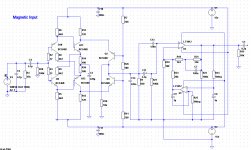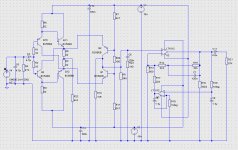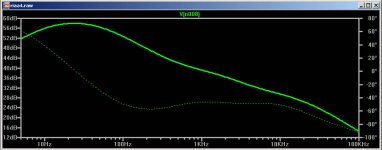Have done a noise sim on this circuit? I think it will be quite noisey.
Q9 to Q12 and the associated resistors all add noise.
Sor SOTA see Syn08's stuff in the analog front end forum - you should get some good ideas.
If you are looking for a basic mag input RIAA, I'd suggest an op-amp based design.
Q9 to Q12 and the associated resistors all add noise.
Sor SOTA see Syn08's stuff in the analog front end forum - you should get some good ideas.
If you are looking for a basic mag input RIAA, I'd suggest an op-amp based design.
I'd prefer to remove the op amps and have an all transistor stage.
Why? There are advantages to monolithic low noise designs, like low drift direct coupled, matching offset, depends really on what your end result goals are.
Op amps like L1037 are low noise optimized for mag inputs while LT1028 for MC's. Depending on topology you can even run them class A with buffers.
Have done a noise sim on this circuit? I think it will be quite noisey.
Q9 to Q12 and the associated resistors all add noise.
Sor SOTA see Syn08's stuff in the analog front end forum - you should get some good ideas.
If you are looking for a basic mag input RIAA, I'd suggest an op-amp based design.
You're right of course, but you obviously havent read my sig
It's not bad at the moment - 2mV signal in to 550mV out - noise of course will be a function of gain also and there is the performance of those two op-amps
anyway, with all of that gain in there it doesnt have much choice but to have some noise - I am just doing this as an idle exercise for fun. I'd like to know if it is possible that the better transistors made today could actually offer more design choices?
Yeah I was just idling trying to figure out how a discrete transistor only RIAA with the proper corrections would look - getting the envelope shape right is a challenge.
Last edited:
- duinno if anyone else has mucked about with RIAA before?
From my pov these exercises are just a waste of time compared to the wealth of info in the currently running MPP thread or the older - Real Vendetta.
I was idle this morning looking at converging several ideas to attept to come up with a precision RIAA stage - duinno if anyone else has mucked about with RIAA before? - I'd prefer to remove the op amps and have an all transistor stage.
I thought the input loading is supposed to be 47K. Isn't this one 32K?
G²
yes, if not lower.
I thought the input loading is supposed to be 47K. Isn't this one 32K?
G²
Perfectly correct guys -- I have stripped back the design - I found the MPP thread informative especially on detailing performance and input impedance on the different types of current mirrors.
I've never done a discrete RIAA stage before and I'm having fun with this...
If you look at Krell, Mark Levinson and Naim - they are all transistor - I wonder if this gives designers more choices to make in producing the high end kit? This idle curiousity of mine continues because I'm going to now convert those two op-amps into all transistor as the big hi-fi names have and see what design compomises can be attacked.
I've never done a discrete RIAA stage before and I'm having fun with this...
If you look at Krell, Mark Levinson and Naim - they are all transistor - I wonder if this gives designers more choices to make in producing the high end kit? This idle curiousity of mine continues because I'm going to now convert those two op-amps into all transistor as the big hi-fi names have and see what design compomises can be attacked.
Attachments
the input devices, q3 and q10, need a dc path to ground. you were on the right track before; you needed to pick another value than 47K to parallel with the 100K to get 47K.
Restore the 100K and change the 47K to 88.7k and it will be spot on - unless your amp has some input loading problems.
G²
Because it's fun?Why? There are advantages to monolithic...
Opamps are boring - 90% of the work is done for you.
So what?Have done a noise sim on this circuit? I think it will be quite noisy.
Vinyl is noisy anyway. You have to screw up a preamp pretty bad before the electronic noise is worse than the surface noise. I remember some phono preamps using shunt feedback getting good reviews because they sounded good, despite their "high" noise.
[OT]
I actually built a phono preamp once with a single 741 - stereo input with a couple of "blend" resistors and mono output. I expected it to be terrible, but it actually sounded OK (in a lo-fi context). Noise wasn't too bad subjectively.
Disclaimer
Maybe I should have prefixed the above with "Hello, my name is Godfrey and I have a confession..."
It was an emergency build. After a burglary, I was left with no audio electronics. Short term, the only way to hear music involved digging into the junkbox to see what I had that could possibly be fashioned into a preamp.
Result: a breadboard with a 741 and some passives that got it almost in the ballpark of RIAA. IIRC, the power supply involved a car battery charger and some caps.
Picture that lying on the floor, hooked up to a horrible Maplin-style power-amp module nailed to a piece of wood via loose trailing wires and a naked pot as a volume control.
Audiophile quality: NO, but it sounded better than I expected and at least I could hear music again. I was happy!
That's probably the most rewarding "DIY audio" project I've ever done.
Purists, feel free shriek now (if you haven't already started).
[/OT]
Cheers - Godfrey
Last edited:
Hi,
This post may be of interest
Turntable Forum :: View topic - The HART RIAA Phono Stage
I use this JLH discrete phono preamp with my Systemdek 11x900.
David.
This post may be of interest
Turntable Forum :: View topic - The HART RIAA Phono Stage
I use this JLH discrete phono preamp with my Systemdek 11x900.
David.
It only takes a couple active devices to make a surprisingly good sounding RIAA preamp. See here. IMO, you should first build a very good inverse RIAA network. I found this to be quite interesting (scroll down to the RIAA article) and it's the one I built. Still, I run a fairly conventional circuit using the National LME opamps. It's hard to beat 'em, and their app note for an RIAA preamp is a very good place to start.
CH
CH
- Status
- This old topic is closed. If you want to reopen this topic, contact a moderator using the "Report Post" button.
- Home
- Source & Line
- Analogue Source
- trying a solid state RIAA



